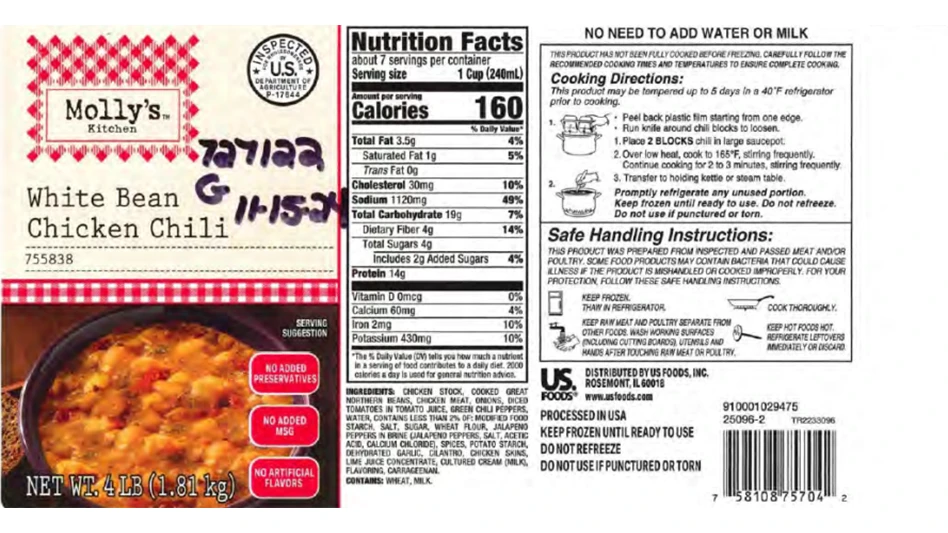
The U.S. Food and Drug Administration (FDA) announced updated draft guidance designed to help food facilities comply with the requirements for current good manufacturing practices (CGMPs) and preventive controls for human food. The new chapter on food allergens outlines ways to ensure protection of food from major food allergen cross-contact and to ensure that the finished food is properly labeled with respect to the major food allergens.
Millions of Americans have food allergies and may experience adverse reactions to products that contain food allergens. While many allergic reactions may involve only mild symptoms, some are severe and may even be life-threatening.
Earlier this year, sesame was added as the ninth major food allergen when the Food Allergy Safety, Treatment, Education, and Research (FASTER) Act became effective on Jan. 1. This means that sesame, when present in a food, is now required to be disclosed on food labels, and firms need to implement controls to significantly minimize or prevent sesame allergen cross-contact.
With the passage of the FASTER Act, FDA and families with sesame-allergic members hoped that it would become easier for those allergic to sesame to feel more confident in their food choices with the clear label declaration of sesame, reported FDA. However, the agency said some manufacturers are intentionally adding sesame to products that previously did not contain sesame and are labeling the products to indicate its presence, rather than take appropriate measures to minimize or prevent cross-contact. This keeps manufacturers in compliance with the law for disclosing the presence of a major food allergen. However, it also limits options for consumers who are allergic to sesame, a result FDA said it does not support.
FDA is encouraging industry to follow the draft guidance on ways to significantly minimize or prevent allergen cross-contact and undeclared allergens and review the examples provided, rather than intentionally adding sesame to their products to comply with the law.
“The FDA is looking for opportunities that could help consumers who are allergic to sesame and other major food allergens find foods that are safe for them to consume,” said FDA Commissioner Robert M. Califf. “We encourage manufacturers to follow the guidelines in the draft guidance updates released today to prevent allergen cross-contact and ensure proper labeling. We recognize there are challenges with ensuring products are free of allergens, and we are engaging with stakeholders on this issue. The agency is interested in finding solutions, within our authorities, that meet the needs of consumers with food allergies. Updating this draft guidance with the new allergen chapter provides one tool to help manufacturers meet this goal.”
Chapter 11 — Food Allergen Program and Chapter 16 — Acidified Foods are among the chapters that have been added since the draft guidance, Hazard Analysis and Risk-Based Preventive Controls for Human Food, was first issued in 2016.
Chapter 11 explains how to establish and implement a food allergen program that ensures protection of food from major food allergen cross-contact and that the finished food is properly labeled with respect to the major food allergens. It provides many examples of ways to significantly minimize or prevent allergen cross-contact and undeclared allergens using CGMPs and preventive controls.
Labeling errors are the cause of most FDA food allergen recalls, reported the agency, and Chapter 11 includes guidance on how to monitor or verify that the food allergens are properly declared as required and the correct label is used for the product.
The chapter also discusses circumstances in which, despite adherence to appropriate CGMPs and preventive controls, allergen presence due to cross-contact cannot be completely avoided and options a firm can consider, including the voluntary use of allergen advisory statements when appropriate. The chapter complements FDA’s recently released Draft Compliance Policy Guide on Major Food Allergen Labeling and Cross-Contact, which reflects the agency’s risk-based and science-based approach for the evaluation of potential allergen violations.
Chapter 16 applies to manufacturers, processors or packers of acidified foods (such as some processed sauces, beans, cucumbers or cabbage that have an overall pH of 4.6 or below). It explains how these manufacturers can use procedures, practices and processes that they have established to meet requirements in the acidified foods regulations to satisfy requirements under the preventive controls for human foods rule.
Latest from Quality Assurance & Food Safety
- Taylor Farms Linked to Romaine E. coli Outbreak as Marler Clark Files Multiple Lawsuits Against Supplier
- IAFNS Announces Winners of Emerging Leader Awards for Food Safety, Nutrition
- FDA Shares Testing Results for PFAS in Bottled Water
- Provision Analytics Adds Food Safety Expert Jennifer Williams to Strategic Advisory Group
- Boston Sword & Tuna Protects Seafood Safety with Mettler-Toledo Metal Detectors
- IFT Releases New Resources to Aid Food and Beverage Industry in Sugar Reduction
- Yum! Brands CEO David Gibbs to Retire in 2026
- Penn State Extension Offers Short Course on Food Microbiology and Safety for Food Plant Workers






